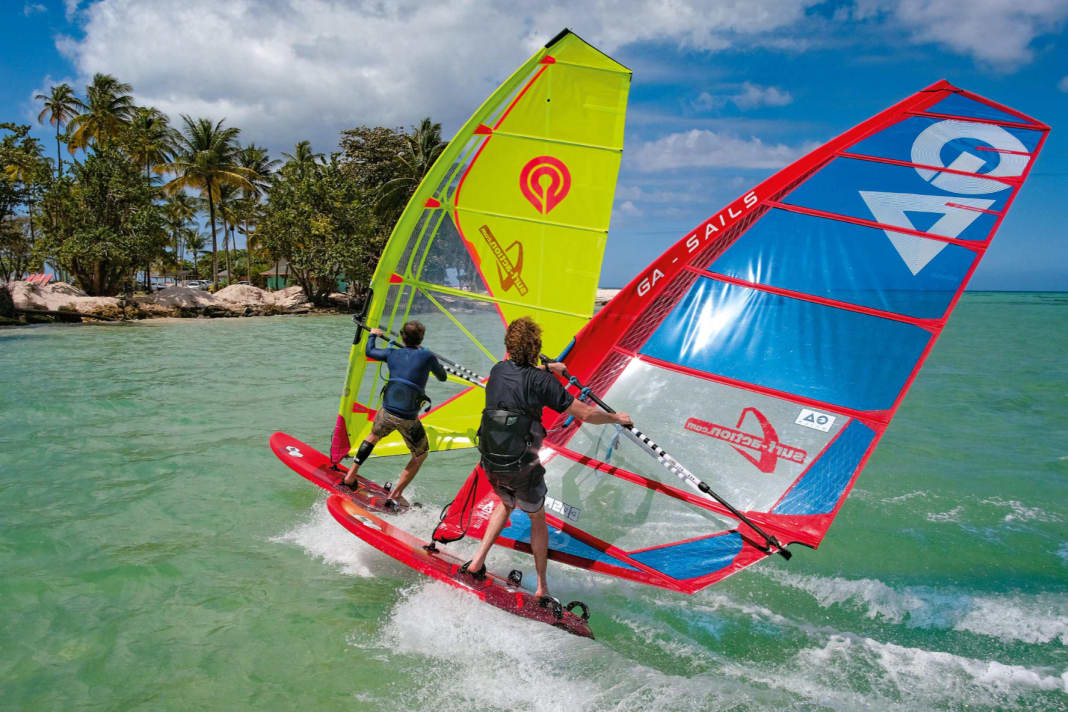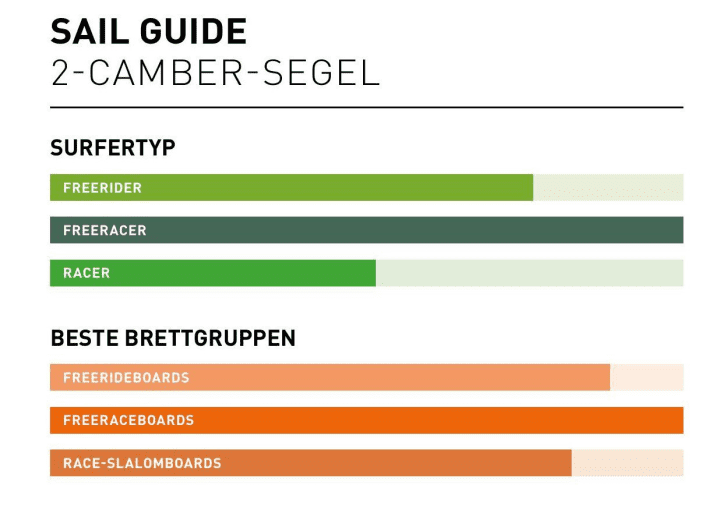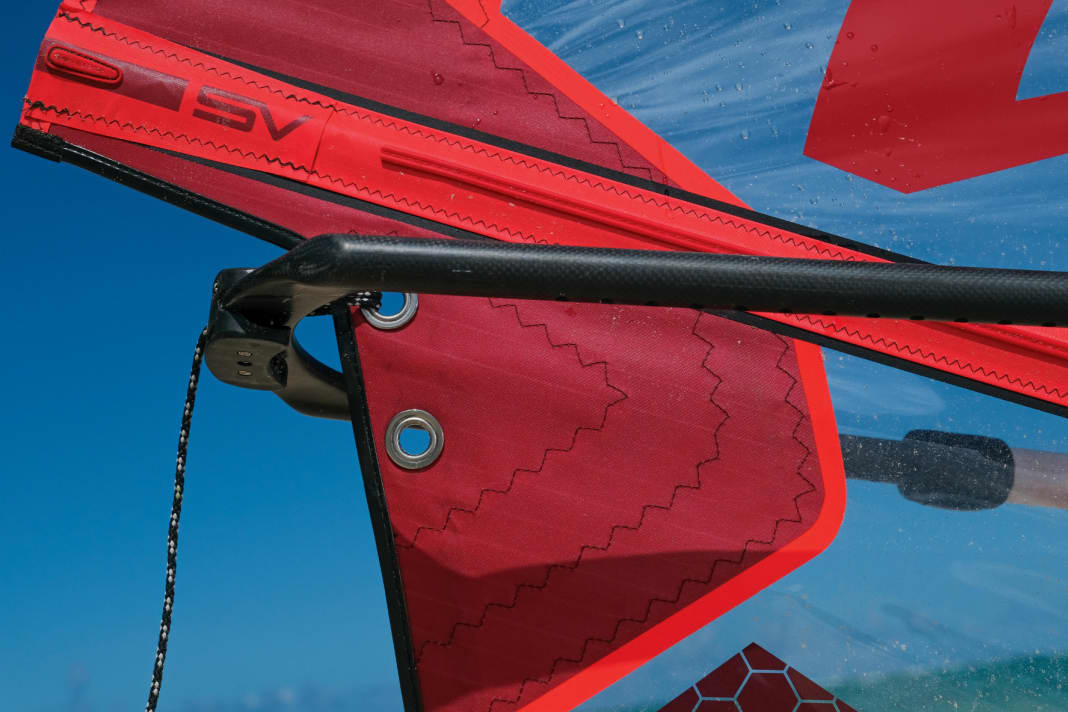





In this article:
These freerace sails are included in the test:
Click to go to the individual ratings

When it comes to the test in the freerace class, the cheeks are puffed out - you try to outwit physics and make yourself a few kilos heavier. You don't let up a single metre, you're breathing under pressure and your pulse is racing. The tight feeling in our hands and fast boards under our feet drive us on. Our teams have been testing together for many years, but on comparison runs, we fight like on the first day. The fast comparison boards with slim slalom fins spur us on. Just like on the empty piste on the first descent in the morning - just let it go, press the pedal to the metal, accelerate until your legs are burning - always with an eye on your partner when testing: Who glides earlier, can I accelerate better in the first few metres? Am I starving to death in a huge wind hole or is the other sail simply pulling better? Or maybe I had two more beers and burgers yesterday?
The performance test removes any question marks. Because while some groups focus primarily on manoeuvrability, camber sails of this size are naturally expected to have plenty of oomph. Yet 2-cam sails offer much more than just brute acceleration. Above all, the neutral, stable handling and the large, usable wind range in one trim ensure continued popularity among many surfers, especially with sails of seven square metres and larger.
For some brands (Goya, NeilPryde, RRD), the 2-cam sails tested are the last step before the race sails - that's as far as you can go in the hobby sector. Other brands offer an additional model designed to close the narrow gap between these test models and professional race sails. These usually have an additional camber and a significantly wider mast sleeve - which, in our experience so far, also result in a noticeable loss of handling.
Construction - with technology and sometimes with strength
The assembly of all test sails is quite simple until the luff extrusion is pushed through - the mast can be pushed into the wide mast pockets above the camber anyway. To fold the camber, the luff is then first tensioned slightly, the clew is pulled to its full length - and all the camber can be easily folded onto the mast. The luff is then fully extended. Only on the Severne Turbo GT did the cambers bounce down again after half the work if the luff tension was not exact, but a little more feeling was required on the Turbo. For the final trim - in strong winds - most sails need a lot of tension on the luff adjuster, with NeilPryde and Point-7 it even gets very pithy.
You won't find any flat-chested models here, all sails offer plenty of belly in the lower area. With the pressure point a little further forward on Severne and GunSails - and tending to be a little further back on NeilPryde and Goya. The mast pockets are still quite moderately wide in this class. The mast pockets at RRD and Point-7 are very interesting - and suspiciously similar. Coincidentally, they originated in Grossetto (RRD) and on Lake Garda (Point-7) close to each other. Perhaps one of them took a closer look at the other. Both place two cambers under the boom and sew the mast pocket much tighter from the boom onwards. On the sails with one camber above the boom, on the other hand, the mast pocket is cut much further upwards. A big difference can be seen in the loose leech of the sails. The loose leech of the RRD, NeilPryde and Point-7, which runs far into the sail and also downwards, is very reminiscent of the race sail look.
The most efficient series engines
At least for the lower and medium planing wind range - from conditions with pumping to powerful but easily controllable full-throttle planing - you will find the fastest cloths on the market here. Especially if you relate this to the cubic capacity, i.e. the volume of the mast pocket. Of course, you can get one or even two knots more top speed out of a race sail with a metre-wide mast pocket - but only if you surf the race harness at least half a square metre larger. There is no need to discuss the significantly higher price and the handling disadvantages - from rigging to jibing to water start - because the 2-cam sails tested here clearly win this rating.
The most important details of the freerace sails tested:






Surf type recommendation for the right freerace sail
There are probably three main types of surfer in this sailing group:
- Camber fans,who use camber sails as a matter of principle and like to be fast on the water - but with as much comfort as possible and without racing ambitions. Because camber sails are simply so stable in the hand. The Goya quickly makes it onto the list as a particularly planing sail, the GunSails as an all-rounder and the Severne as particularly light and easy to surf.
- Ambitious freeriders and freeracers, who are on fast freeride boards, but more likely on freerace boards - and who also like to hold back on the lake when another surfer approaches from behind. If you find yourself here, you have almost a free choice. Which sail suits you will depend more on whether you often surf underpowered - in which case GA Sails, Goya and NeilPryde will be your first choice. Or whether you always reach for the larger sail when in doubt: in this case, the sails from GunSails, Neil-Pryde, Point-7, RRD and Severne are the preferred choice.
- The not uncommon target group, which is at leastFreerace-,perhaps even toRace slalom boardssurfers. Surfers who love the race feeling but don't want to struggle with heavy, unwieldy and thoroughbred racing sails. Three sails are particularly recommended for them: NeilPryde, RRD and Point-7, which combine the appropriate performance and controllability with a tight ride. GunSails and Severne also compete in terms of performance, but are somewhat more subdued and subjectively not quite as racy.
However, for surfers who always look wistfully at the race sails, some brands still have alternatives in their programme that perfectly extend the range from this test: Freerace sails with even wider mast pockets and usually three cambers, which - with all their advantages and disadvantages - are positioned very close to the race sails. These are GA-Sails Phantom, GunSails Vector, Point-7 AC-K and Severne Overdrive.
Overview of the strengths and weaknesses of freerace sails
In terms of performance, all sails in this group are between good and super - good standards also dominate in terms of handling. This refers to the tested sail size, in which the camber does not interfere much with gybing.






All freerace sails 2023 in the individual rating
Click here for the detailed test results of all the sails tested:
Freerace sail 2023 between 7.5 and 7.8 square metres with 2 cambers in the video
Also interesting:
- Freeraceboards Large in the big comparison test
- System comparison boards: Freeride - Freerace - Race
- How to find the right fin for freeride and freerace
- All fins for freeride and freerace at a glance
- How surf tests, part 1:How is the test material selected, who are the testers?
- How surf tests, part 2: How does a test work? How are the judgements made?

